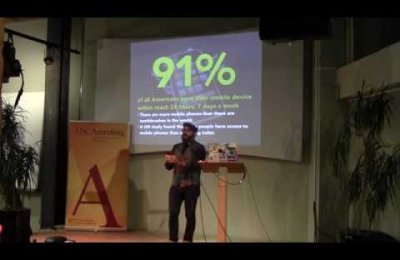In life, Ruben Salazar was a prominent and popular newspaper columnist for the Los Angeles Times and news director for television station KMEX. In death – and the horrible story of his slaying is well-told here and elsewhere – Salazar morphed in some circles to being as much martyr as man, as much symbol as son, as much postage stamp and mural painted on a civic center wall as regular guy. A recently posted USC Annenberg and USC Libraries effort sets out to help restore Salazar's humanity. "For the last 42 years, we read the same paragraphs over and over: 'Newsman Salazar, 42, killed August 29th at Chicano Moratorium,'" says Lisa Johnson Salazar, Ruben Salazar's oldest daughter. "Now there is a site you can go to and learn the personal side to Ruben Salazar."
That site, the Ruben Salazar Project, was created during the Spring 2012 semester by nine undergraduate and graduate USC Annenberg students. They are: Elaine Baran, Melissa Caskey, Juan Espinoza, Regina Graham, Gustavo Gutierrez, Grace Jang, Elena Kadvany, Bianca Ojeda and Frances Vega. The Project, a partnership with USC Libraries, was directed by USC Annenberg Professors Félix Gutiérrez and Robert Hernandez. The Project spotlights milestone documents, images, objects and ephemera culled by the students from the USC Libraries' Ruben Salazar papers. The items were then digitized, coded and placed in an image-rich online timeline that also includes a collection of articles byeach of the students.
The students employed their own editorial judgment in selecting what from the Libraries' 30 linear feet worth of the Salazar collection was worth immediately placing online. "We didn't tell them, 'We need a piece on this, somebody needs to talk about that,' Gutiérrez says."We want students to use this site. This is not for `60s people to relive their Chicano Movement days or their glory days at the L.A. Times. This is, 'What would young people want?'" Salazar Johnson pondered similar questions. "As I was putting together the material to be sent I grappled over several pieces that I wasn't sure what to do with," Salazar Johnson said. "Would the library really care about this or does this add to the collection?" One of those last-minute additions was a menu from Lucy's El Adobe Cafe. "It even had a stain on it and I thought about just throwing it away," she says. "But in the story, 'Mapping Salazar's Life,' the student [Melissa Caskey] was able to use that to compare prices of enchiladas verde back then and what it would cost today. And, of course, Lucy's El Adobe was where my dad frequently dined." Items selected by other students for the website ranged from Salazar's correspondence regarding a credit card dispute to an ode to his briefcase to "the missing years" that the journalist spent working in Northern California. USC acquired the Ruben Salazar Papers in 2011 thanks to the generosity of the Salazar family (including his youngest daughter, Stephanie Salazar Cook, and his son, John Salazar) as well as the recruiting and organizing efforts of Gutiérrez and Barbara Robinson. Robinson is the Librarian for Spanish and Portuguese, Latin American and Chicano/Latino Studies at the USC Libraries Boeckmann Center for Iberian & Latin American Studies. She points out that one of the stated goals of the USC Libraries is to "become more thoroughly and systematically integrated" into coursework and learning. "I hope," the librarian says, "the Salazar Project will inspire other courses in Annenberg to make use of some of the many interesting archival collections in Special Collections." The website may have been the result of Guiterrez’s semester-long directed research course, but the larger USC Annenberg connection is decades in the making. "The Ruben Salazar Project is a continuation – and perhaps culmination – of about a 30-year interest in Ruben Salazar here in the School of Journalism," Gutiérrez says. That interest ranges from an undergraduate's long-ago filing of Freedom of Information Act requests related to Salazar; to a forthcoming Salazar documentary being made for PBS by Annenberg visiting fellow Philip Rodriguez; to the school's longtime hosting of the California Chicano News Media Association, a group that Salazar Johnson has visited with and that Gutiérrez used to executive direct. Gutiérrez's personal interest in Ruben Salazar predates his professorship. "[Salazar] has been a role model for me when I was an undergraduate student at Cal State L.A. in the early `60s," Gutiérrez says, "when, really, he'd been the only Latino journalist covering Latino issues that I could identify at the time." Adds Gutiérrez: "He had the career I would have liked to have had." With the Ruben Salazar Project online – and more work likely to continue this semester and perhaps beyond – those careers now overlap just a bit more. So too do the experiences and understanding of a new generation of beginning Salazar scholars. "My highest dream when I gave Felix the time to do this," says Geneva Overholser, director of the School of Journalism, "was that it would end up not only making the materials in this archive available more widely, but really touch some individuals' lives. And I think these students will always remember this." So too, it seems, will Ruben Salazar's family. "I never had any doubts about donating my father's papers to the USC Libraries," Salazar Johnson says, after clicking through the Ruben Salazar Project. "And today I have never been so proud that I did."
- The Ruben Salazar Project is available online here.
- For more information about the Ruben Salazar papers, visit the USC Libraries page.
- Gutiérrez will demonstrate the Ruben Salazar Project to librarians, staff and special guests in the Special Collections area of Doheny Memorial Library on Oct. 11 from 11a.m. until 12 p.m.






